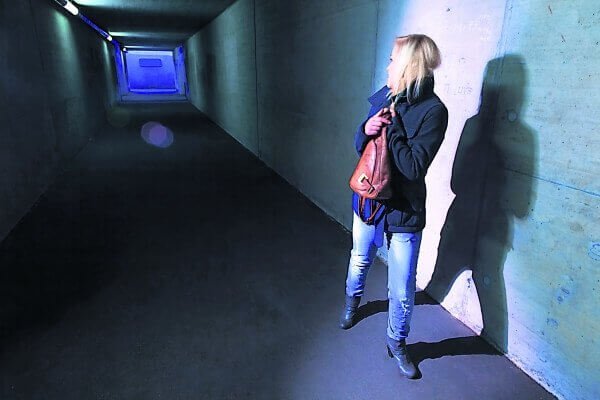Paranoid Schizophrenia: Definition, Causes and Treatment

Surely on more than one occasion you’ve heard someone say “they’re paranoid”. It is not uncommon for us to use the term “paranoid” for someone who things someone is following them, who wants to hurt them, who makes fun of them or who is against them. However, academically speaking, the term paranoid is something more than that. In this post we are going to talk about a subtype of psychosis, paranoid schizophrenia.
Historically, the term “psychotic” has been defined in several different ways, none of which has been universally accepted. We understand “psychotic” as a person with a specific set of symptoms that are put in two large groups: positive symptoms and negative symptoms. Let’s look at them in detail.
Schizophrenia, a serious mental illness
The DSM-5-TR (Diagnostic and Statistical Manual of Mental Disorders) defines schizophrenia as “two (or more) of the following [symptoms], each present for a significant portion of time during a 1-month period (or less if successfully treated)”. These symptoms are the following: delusions, hallucinations, disorganized speech, grossly disorganized or catatonic behavior and negative symptoms.

Positive symptoms are an excess or distortion of normal functions, while negative symptoms are a decrease or loss of normal functions. Positive symptoms include distortions of reasonings (commonly called delusions, including those “paranoid” ideas discussed earlier). They also include hallucinations, disorganized speech and grossly disorganized behavior.
On the other hand, negative symptoms include the following. Restrictions in the scope and intensity of emotional expression (flat affect), loss of fluency and productivity of thought and language (alogia), and the absence of willpower (abulia).
Delusions are wrong beliefs that usually come from a misinterpretation of experiences or perceptions. It can be about many things (eg, persecution, self-reference, illness, religious or grandiose). Delusions of persecution are the most frequent.
A person who has the delusion of persecution (they are paranoid or have paranoid ideas) believes that someone is bothering, following, cheating, spying on, or ridiculing them. Self-referential delusions are also common: this is when the person believes that certain gestures, comments, passages of books, newspapers, songs or other elements of the environment are especially meant for them.
Another example of a delusional idea is the belief that a strange being has stolen their internal organs and replaced them with those of another person without leaving any wound or scar. Delusions that express a loss of control over the mind or body are generally considered strange.
Delusions can generate social, relationship, or labor problems. People with delusional ideas may be able to understand the arguments of other people and consider that their ideas are irrational. However, they are unable to accept it. Many of these people can become very irritable. At the same time, this irritability can be a reaction to their delusional beliefs.

Psychosis or paranoid schizophrenia
There are different types or subtypes of schizophrenia according to the DSM-5-TR:
- Paranoid.
- Disorganized.
- Catatonic.
- Childhood.
- Schizoaffective.
As we have said before, in this article we are going to focus on paranoid schizophrenia.
Characteristics of paranoid-type schizophrenia
The main characteristics of paranoid schizophrenia are clear delusions or auditory hallucinations. However, the person has no problems with thought flow or emotions. Generally delusional ideas are about persecution, greatness or both, but they can also be presented with another theme (eg, jealousy, religiosity or illness).
There can be multiple delusions with paranoid schizophrenia, but they usually have a coherent theme. It is also common for hallucinations to be related to the delusional theme.
“The main characteristics of paranoid schizophrenia are clear delusions or auditory hallucinations.”
Symptoms associated with paranoid schizophrenia
Associated symptoms include anxiety, anger, withdrawal and tendency to argue. They may have an air of superiority and condescension. It can also be pompous, dull, unnatural or have extreme vehemence in personal relationships.
The feeling of persecution may make them prone to suicide, and the combination of delusions of persecution and greatness with anger reactions may cause them to act violently (although this is not necessarily the case, it varies by person).

In this sense, spontaneous or unexpected aggressions are rare. Aggression is seen more in young males and in individuals with a history of violence, problems staying in therapy, substance abuse and impulsivity. In any case, we have to be clear that the majority of people with schizophrenia are not aggressive. Moreover, they are victims of aggression or abuse more frequently than people who do not have schizophrenia. They are potential victims more than potential aggressors.
“Everyone’s a little crazy. Some people just hide it better than others.”.
-Michelle Hodkin-
The onset of paranoid psychosis tends to be later than in other types of schizophrenia. Also, it’s characteristics can be more stable over time. Some data suggest that the outlook for people with paranoid schizophrenia may be considerably better than for other types of schizophrenia. In general, these people are usually able to lead a life with a high degree of autonomy.
What are the causes?
The causes are still not entirely clear and are controversial. In any case, there are some risk factors:
- Environmental factors: the season in which a person is born may be a factor, such as late winter or early spring in some areas. Schizophrenia and related disorders are higher in children growing up in an urban environment, as well as in some minority ethnic groups.
- Genetic factors: genetic factors are very important contributors to schizophrenia. It comes from both common and rare gene mutations. These mutations are also associated with other mental disorders, such as bipolar disorder, depression and autism spectrum disorder.
- Physiological factors: pregnancy complications and childbirth with hypoxia (lack of oxygen), and a greater paternal age cause higher risk of the developing fetus suffering schizophrenia. In addition, other negative prenatal and perinatal situations, such as stress, infection, malnutrition, maternal diabetes and other medical conditions, can be associated with schizophrenia. However, the vast majority of children who have these risk factors do not develop schizophrenia.

Treatment of paranoid psychosis
Chronic paranoid psychosis is treated with a combination of drugs, mainly neuroleptics, antipsychotics, anxiolytics and support through psychotherapy. However, patients rarely take treatment correctly because they are not aware of the illness. They feel bad, but think that it is because of what happens to them, not something in their head. They take pharmacological treatments for life. In severe cases, hospitalization should be considered.
As we have seen, paranoid type schizophrenia has different characteristics than other types of schizophrenia. Delusions of persecution, greatness or both are common. However, they are more or less capable of reasoning, which allows them a high degree of autonomy.
Bibliography:
- American Psychiatry Association (2014). Manual diagnóstico y estadístico de los trastornos mentales (DSM-5), 5ª Ed. Madrid: Editorial Médica Panamericana.
-
Chinchilla Moreno A. Las esquizofrenias. Barcelona: Elsevier Masson; 2007.
This text is provided for informational purposes only and does not replace consultation with a professional. If in doubt, consult your specialist.








